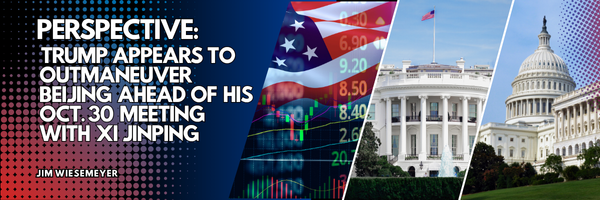
U.S. Offers Tariff Relief as China Signals Return to U.S. Soybeans — Broader Farm Buys Possible
Beijing expected to delay rare earth export curbs as Washington extends olive branch; soybeans take center stage, with sorghum and cotton poised for potential inclusion
President Donald Trump appears to have outmaneuvered Beijing ahead of his Oct. 30 meeting with Chinese President Xi Jinping, using a calculated mix of tariff restraint and targeted trade incentives that could reset the tone of U.S./China economic relations.
After two days of intensive talks in Kuala Lumpur, U.S. Treasury Secretary Scott Bessent announced that the two sides reached a “very substantial framework” to avert Trump’s threatened 100% tariffs on Chinese goods. In return, China is expected to delay its planned export-control regime on rare-earth minerals for one year and resume large-scale purchases of U.S. farm commodities — a move that could bring long-awaited relief to American agriculture.
Tariff Reprieve and Rare-Earth Concessions
The framework gives Beijing a breathing space on its critical-minerals licensing plan, which had been slated to tighten global supplies of rare-earth elements vital to defense and high-tech manufacturing. According to Reuters, China’s one-year suspension will be paired with a review process that allows for renewed dialogue before any new rules take effect.
In exchange, Washington is expected to withhold its 100% blanket tariff escalation, originally designed to punish nations not aligned with its “reciprocal tariff” framework. Bessent described the outcome as “a win for both sides,” noting that the U.S. had “secured significant commitments on agricultural trade and supply-chain transparency.”
Soybeans Back at the Core of U.S./China Trade
The clearest benefit for U.S. producers lies in agriculture — particularly soybeans, the symbolic centerpiece of America’s farm exports to China. After a year of halted purchases, Beijing is now expected to re-enter the U.S. soybean market immediately following the leaders’ meeting in South Korea this Thursday.
While no precise tonnage has been disclosed, Bessent told reporters that U.S. soybean farmers “will feel very good, both for this season and the coming seasons for several years.” Analysts note that the resumption could restore a key outlet for the 2025 harvest, which had seen zero Chinese cargo bookings through September — the first such drought in seven years.
Agriculture groups welcomed the development. The American Soybean Association praised the framework as a “major step toward rebuilding export momentum,” saying it “reopens market access that sustains hundreds of thousands of U.S. farm jobs.”
Other Commodities: Sorghum and Cotton on Watch
Beyond soybeans, trade experts believe sorghum and cotton could also feature in Beijing’s broader farm-purchase package, though neither has been formally listed in the draft framework. These crops were part of China’s prior “Phase One” commitments under the 2020 trade deal and have since seen depressed export volumes.
U.S. officials familiar with the negotiations say both commodities are “eligible for inclusion” as China seeks to demonstrate breadth in its agricultural purchases. However, sources caution that near-term demand may remain modest given China’s ongoing diversification of supply from Brazil and Central Asia.
Still, the potential return of Chinese buying interest — even at moderate scale — could lift prices for sorghum and cotton producers hit hard by retaliatory tariffs and falling global demand.
The Strategic Layer: Trump’s Leverage in Southeast Asia
At the same time, the Trump administration has cemented several trade pacts across Southeast Asia, including with Malaysia, Vietnam, Thailand, and Cambodia. Those deals grant tariff exemptions and investment preferences for partners aligned with U.S. supply-chain and regulatory goals — effectively offering an alternative to Chinese-centric trade channels.
By securing new critical-mineral partnerships in the region and binding those countries to transparency requirements, Washington has undercut Beijing’s leverage on the materials front — a core Chinese “card” in past trade showdowns.
Looking Ahead
The Kuala Lumpur framework now sets the stage for Thursday’s Trump/Xi summit in South Korea, where both leaders are expected to finalize the arrangement. If confirmed, the pact would combine immediate rare-earth relief, renewed agricultural purchases, and a temporary tariff truce — marking the most significant thaw in U.S./China relations since 2020.
Yet the fine print will matter. The framework’s success will depend on China’s follow-through on farm commitments and U.S. restraint from re-escalating tariffs if Beijing’s purchases lag. For now, soybean markets are reacting optimistically, with analysts calling the agreement “a partial détente with global ripple effects for commodities, manufacturing, and inflation.”



